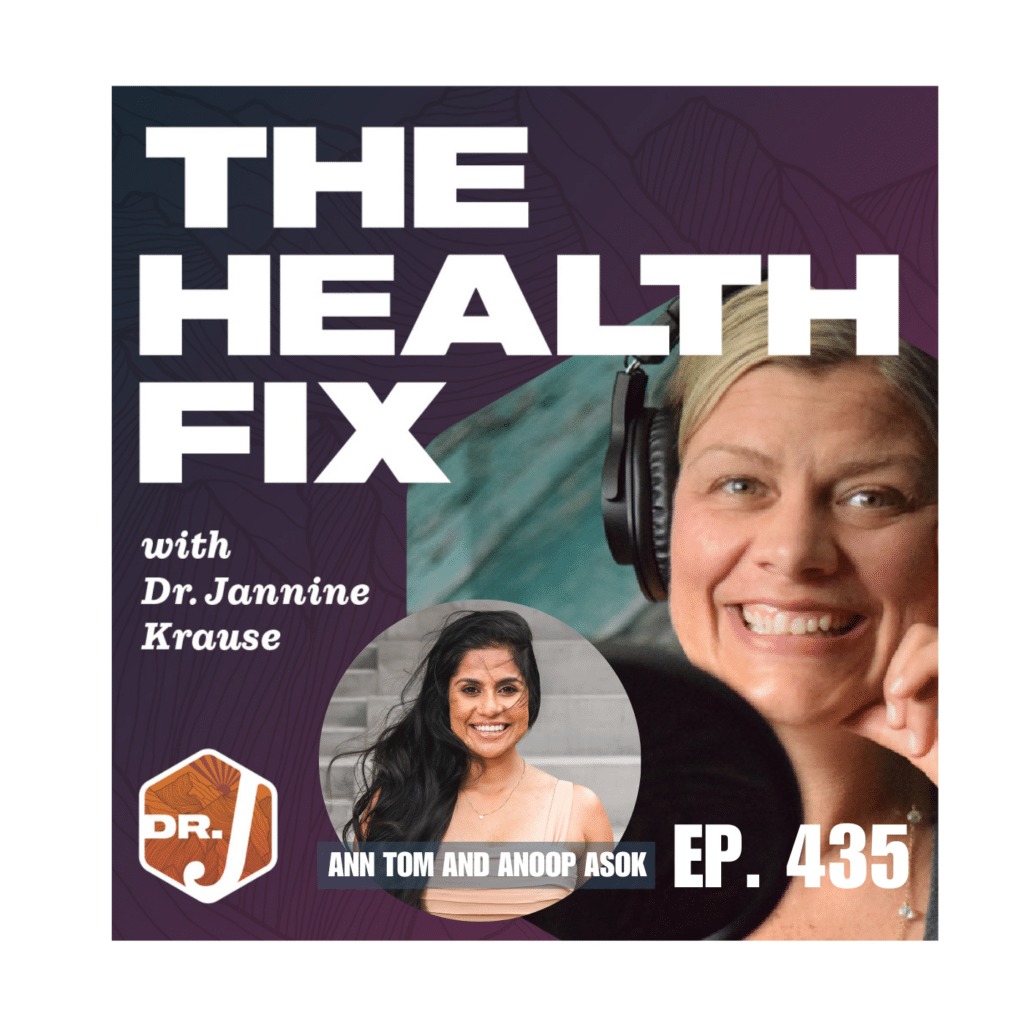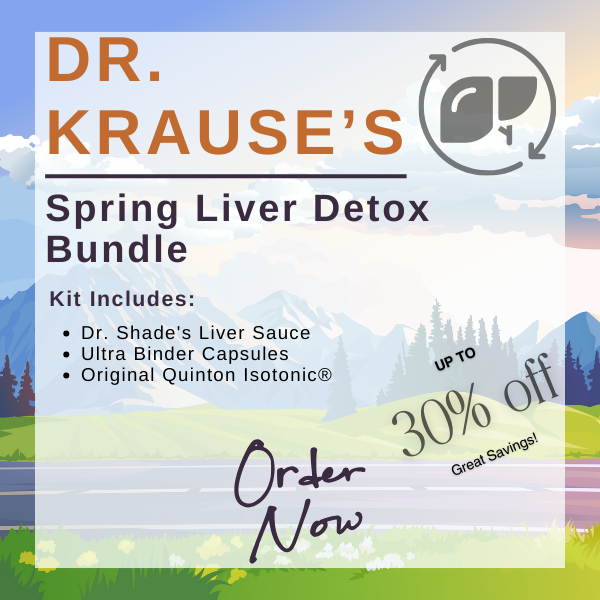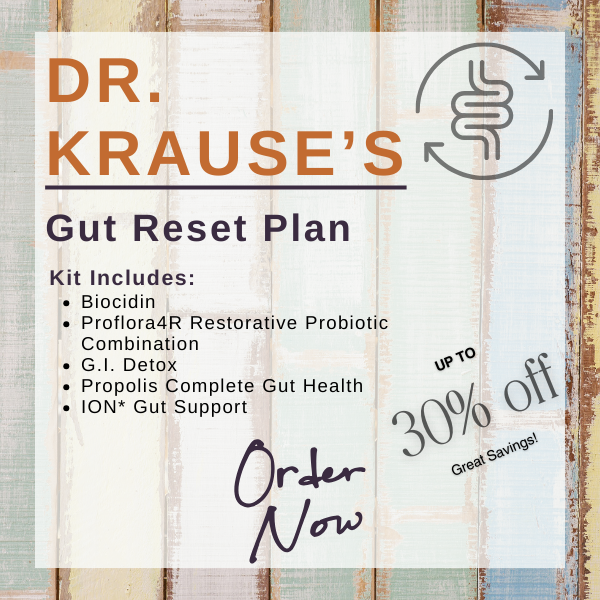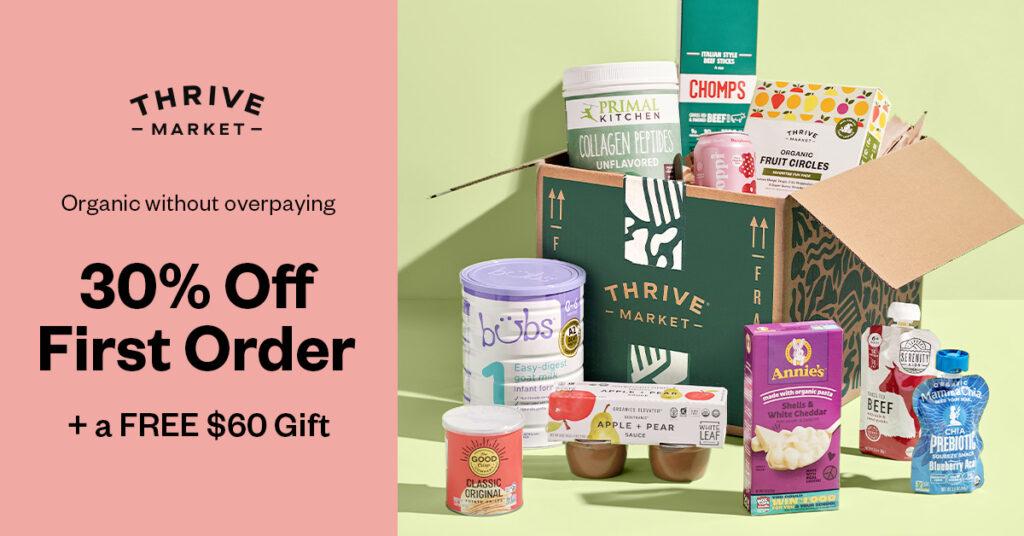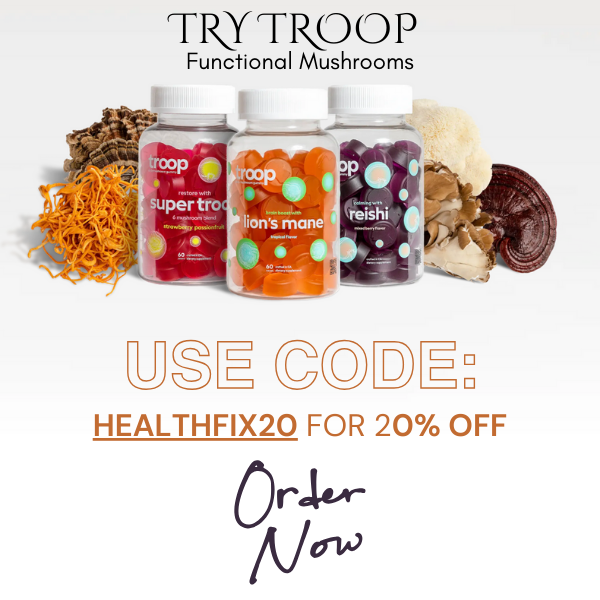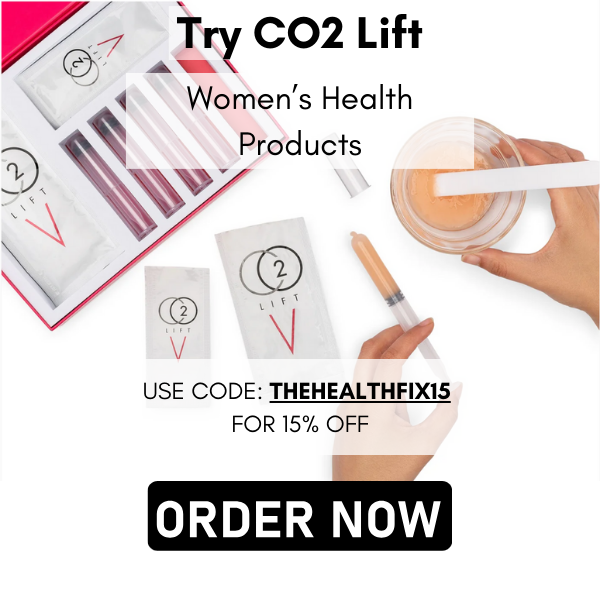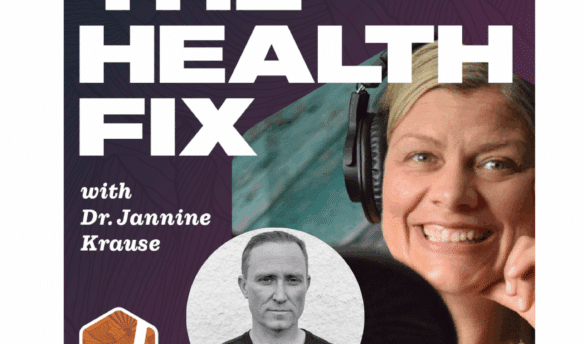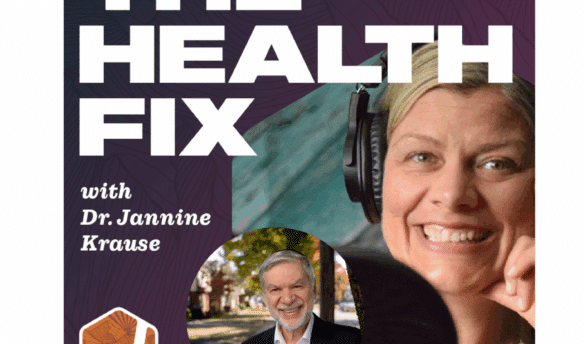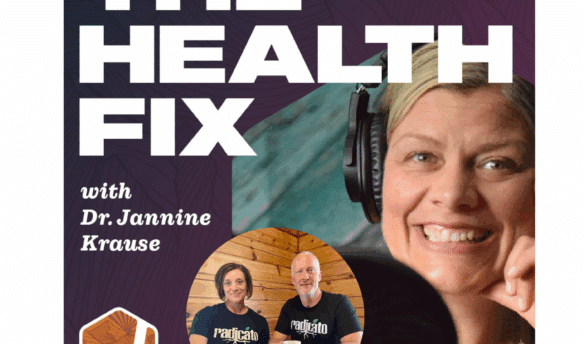Trying to figure out what to do with your metabolism and tired of restricting your favorite foods? Busy juggling work and family life while trying to find time to care for yourself? Ann Tom and her husband Anoop Asok understand the needs of busy professionals raising kids and they’ve created a Metabolic Mastery Program to help busy clients understand their individual metabolisms. With a decade of experience as ER nurses, Ann Tom and Anoop Asok bring extensive knowledge of anatomy, physiology, and hormones to their coaching and they are on a mission to help folks live healthier and happier lives. In this episode of The Health Fix Podcast, Dr. Jannine Krause interviews Ann Tom and Anoop Asok on myths, tips and how blood sugar spikes are keeping your weight on.
Dr. Krause’s Protocols
Instructions Included
Traveling soon? Looking to detox or reset your gut? Try one of Dr. Krause’s Fullscript plans.
What You’ll Learn In This Episode:
- Why fasting can be harmful with PCOS
- Best time to eat carbs to prevent fat deposition
- Why pairing protein/good fat with carbs helps prevent sugar spikes
- An easy hack to eat your favorite foods
Resources From The Show:
- Metabolic Mastery Program at Ann Tom Fitness
- Instagram: @ann_maria_tom
- Midlife Metamorphosis Plan
- Book mentioned in the podcast – Glucose Revolution
Our Partners
Podcast Transcription
1:46 – Ann and Anoop’s background story
9:50 – Keeping metabolism down helps with PCOS
15:00 – Can you really eat whatever you want?
17:46 – Timing of when you eat is important
20:38 – Tips for breakfast on the go
25:59 – Food portions
29:05 – Thoughts on following a diet
32:31 – Hacks for eating whatever you want
37:21 – How to get the fiber in
40:28 – Why fiber is important
41:38 – More info on Ann and Anoop’s Metabolic Mastery Method
44:25 – Free gift offer
JANNINE: [Intro](upbeat music) Welcome to the Health Fix Podcast,
where health junkies get their weekly fix of tips, tools,
and techniques to have limitless energy,
sharp minds, and fit, physiques, or life.
– Hey Health Junkies,
on this episode of the Health Fix Podcast,
I’m interviewing Ann Tom,
the founder of Ann Tom Fitness.
Now she’s working alongside her husband, Anoop Asok,
and they’re both gonna be on this podcast
where they talk about helping women with weight loss
in really using their background as ER nurses
to bring up their extensive knowledge
of anatomy, physiology, and hormones,
which they apply in their approach to weight loss,
otherwise known as metabolic mastery method.
So we’re gonna go into that.
We’re gonna talk and get very real on weight loss
and what it takes.
So this is a fun podcast.
Let’s get on with it.
Hey, health junkies.
I have Ann and Anoop on today,
and we’re going to be talking
about their metabolic mastery method,
some other things too, like,
I don’t know, weight loss and getting our bodies in shape
and feeling good about ourselves
’cause isn’t that the ultimate goal here.
So, Ann, Anoop, welcome to the Health Fix Podcast.
ANN & ANOOP: Thank you. – Thank you so much
for having us. – Yeah.
JANNINE: Well, I’m excited to chat because of course,
you know, this podcast is gonna be coming out
in the beginning of the year when folks are all kind of
thinking like, hmm, is this the year?
I’m not even gonna go there on resolutions.
I’m just gonna be like, is this the year
that I get my body shape.
Is this the year that by my birthday,
I have X, Y, or Z going on.
And so it’s timely.
And of course, with any podcast,
I always start out asking folks,
how did you all get into deciding
that metabolism helping folks lose weight was your jam?
ANN: Sure, is it okay if I give you like a little bit
of a background because–
JANNINE: Absolutely.
ANN: Yeah, sure, okay.
So, you know, we started this at a midst of COVID
when everything was shutting down.
that’s when we actually started this method
to help more people because we felt like that
is the time period that most people need more help
when it comes to their health and fitness than ever.
So one of the reasons why we started,
but another thing would be is that I wanna let,
I like to take you back like 12 years or 15 years,
like before, like in your past and early, early in time.
I vividly remember like this one night,
I went to bed so hungry, right?
thinking that, you know, it’s just a 12 hour fast, right?
I can break it the next day for the breakfast.
And waking up, I realized it was an unintended 18 hour fast.
I was like, shoot.
I thought I can eat my breakfast,
but I have to wait until lunch.
And, you know, I was living with my mom at that time period
and she cooks the most amazing South Indian food
and no one can say no to it, right?
So I was like really anticipating to eat that beautiful lunch
that she cooks on a daily.
but at lunch, you know, I cried not because of the joy, you know, that I get to eat all this food,
but because my stomach really hurt, you know, one thing I want to tell you that is that this was
the third time I was visiting the emergency department for gastritous flare up and just
keep this in mind that I was only 20 years at that point, right? And my doctor came in and said,
you know what, and this has been going on for such a long time and now it’s not a guest writers
anymore, it has developed into an ulcer. And at that point, I didn’t really know what this
ulcer was, right? But it felt like a word, like ulcer. Oh, that sounds gross. Like, right?
I was so scared and like, frozen, I can’t even feel that in my nerves at this moment, right?
I questioned myself, what have I done to myself all these years, right? I couldn’t really believe
like, I was doing this to myself. And two months later, he put me on pantoprosol. So if anyone
doesn’t know what pantoprosol is, it is like on another ulcer medication. I really felt better
because you’re on medication right now, right? But I went into the ER again, not for asthma flare up
this time, but this time around it was for, sorry, gastritis flare up. This was for an asthma flare up
this time around so my doctor was like hey and you’re back again what’s going on you know we’ve
been looking to do your lung capacity test for the past few months and we have the reports now
and you have a very terrible lung capacity at 22 years old okay because yeah one thing I want to
tell you is that I was so inactive at that point and I was also starving myself to death by not
eating any food because I was constantly worried about me getting fat, right? Because we have this
societal pressure of having a tummy that that should look like a flat cardboard board, right?
Or we always compare ourselves to this beautiful models that we see on Instagram and and internet.
So I was really wanting to have that kind of a tummy. So the only thing I could do to myself
to get there was actually starving myself to death.
So another thing was that I really remember this, like climbing stairs was a big task for me.
I could not like run up the stairs, you know, like a 20 year old can, right?
I always felt like like an 80 year old, even I was looking like a 20 year old.
I’m giggling at this moment, but that time was really not something that I, you know,
wanted at that point in my life and I was a dancer. I could not dance anymore because of my
battling capacity and I passed out during one of the performances. JANNINE: Oh wow.
ANN: On stage and the doctor
said, you know, you cannot do a lot of activity at this moment. You really need to improve your
cardiovascular capacity if you want to do something like this. And I remember going back home that
day looking at my reflection in the mirror and thinking, who is this person? I cannot really look
at her anymore. She looks so frail, she looks not confident. I really felt like I can’t even
ever date a man ever, right? Like no one wants to date me ever. One of the reasons why I thought
Jannine was also because I was diagnosed with PCOS, just polycystic ovarian syndrome. And I had
multiple cysts on my ovaries. They called a chocolate cyst or whatever. The only chocolate
What I know is that the chocolate that you eat, right?
So I had this chocolate system, the doctor said, and conceiving is not something that
you can think of, okay?
You need to go on birth control pills, you know, all those hormonal things and stuff
like that.
So I really felt like my heart was so pounding that the doctor said these words.
And like, it was literally a very bad experience.
I don’t even want to talk about it.
It’s really making me know I should at this point, like really going back and thinking
about the things that I felt back then. Fast forward 12 years, I met this amazing guy sitting
right next to me at the moment. He was really eager to date me, but I didn’t really feel worthy.
I felt not confident. I felt I am not worthy to date a man because who wants to date someone,
who cannot give them kids, right? And I looked and felt terrible. The funny part,
though, is Jannine, is that he also felt the same about himself. He was a really thin man.
So we had a lot of body image issues as well.
So we were both in this together.
So at that point, we were both nurses.
So we worked in the emergency department
and we have a health record working
for over 10 years in the ER and critical care units.
We had a fairly great understanding
of human physiology and how everything works,
but that was not really enough
for the weight loss perspective, right?
‘Cause all we knew is eat less,
exercise more, you lose weight, right?
was a strategy we were using and we did a lot of trial and errors and things like that and
finally we decided to let’s go get certified let’s really you know jump into this dive deep
and figure out what exactly is keeping us as stuck so we went and went ahead and got certified as
nutritionist as trainers and hormonal experts. I’m on my way to getting certified as holistic
hormonal health practitioner because I’m really passionate about that at this point and then we
we discovered this metabolic mastery method,
what we call right now.
And it’s a way where you can technically eat
whatever you want, right?
And lose weight at the same time, right?
Today we are happily married, we have two beautiful kids
which once doctor said, I could never have.
Just imagine like learning to enjoy eat,
to eat food guilt-free, right?
Breaking free from that reward punishment cycle
that we put ourselves into.
That freedom you give yourself is like unmatchable
to anything else, like you have to truly experience it
to really know what it feels like from there,
it’s not going back.
You’re not going to go back to that starvation anymore.
So now what we do is we guide women all over the world
through this incredible journey,
what we call the metabolic mastery method,
so that they can finally get in shape, right?
Lose that belly pooch, gain more strength,
play with their kids, run up and down the stairs,
how many over times they want,
without going on fad diets or spending hours in the gym.
So that’s what got us started to start this coaching.
JANNINE: So, so incredible, so incredible.
You know, I think your story is so common
in terms of how women are feeling
and especially we add the weight,
not feeling confident with ourselves on top
of the whole concept of, oh, and now I have PCOS.
And I mean, gosh, I work in the hormone industry,
myself, and it’s probably one out of every three women that come in are dealing with
those kind of things.
And, you know, I have to have to say that it seems, and I’d love to hear from your experience,
that once you get the metabolism down, the PCOS doesn’t seem to be a factor anymore.
Is that kind of what you guys experienced as well?
Yeah, exactly.
Because one of the things that food does to your body is like really mess up with your
the way the insulin processes, right? How we, you know, dye just sugar and things like that.
So that is one of the things that starvation, like not, you know, doing all the kinds of diet
can really do to yourself without you really knowing about it, right? Most of people going
through PCOS doesn’t really know this piece, right? And they keep doing, you know, diets after
diets like keto and this and that and so many other things because society has them to do it,
or internet says their friend does it, and it worked for them, right? And they think,
sit there and think, oh my god, I tried everything else that I can, but I’m still stuck, right?
And they don’t understand that metabolism is like, it’s like like engine, right? For a car,
that’s how it works for a body. Without it, you’re nothing, right? You’re not going to lose anything,
or you’re not going to gain anything. So I feel like that’s where this piece comes into play,
and why this is so important, that, you know, knowledge around the concept of improving your
metabolism is not there yet. So hopefully, we can, you know, experts like us can get that
word out there so that more people get to know it and they can ditch the diets.
JANNINE: Absolutely. I mean, I saw on your guys’ website that you had a lot of women that were showing
their before and afters and on very restricted calorie diets and then having more calories in
and really the difference in the body composition then.
And I think a lot of people,
you know, unfortunately, the fasting concept
has been really pumped into us for us to think that
if we fast, that’s gonna be the magical way to lose weight.
But as you’ve noticed,
and I see Anoop giong, no,
I wanna hear his opinion too here soon.
ANOOP: I think it’s like really misinformation.
Like most of them, when they go on diet
or when they go on like fasting routine,
They don’t read that literature behind that enough.
They don’t read the science behind that enough.
And they just jump into it because they see, hey,
my friend have seen this many pounds off within a month.
And yeah, they’re doing amazing.
In six months, they lost 20 pounds, 30 pounds or even more.
And they look amazing, they feel amazing and all those stuff.
But that’s not the whole picture.
what happened one year after that,
they don’t really look into it.
And whenever they started on diet
or intermittent fasting or whatever,
they don’t stick for the rest of the life.
It’s just for a couple months or maybe like an year.
And at that point, they’re like so fed up of that process,
they stop doing it.
And what happens when they stop doing it?
It’s like the whole way, whatever they lost,
it just comes back with the vengeance.
It’s just so crazy.
Like, why would you, I was like,
why would you do something knowing that that’s going to come back like if the
weight is going to come back why would you do something like why would you go
through such a hardship such such restrictive things to just lose some
weight off for just such a short years enough time and then after when you
stop doing it it just within few months or even less than a month that weight
will come back even sometimes even more like I couldn’t like it’s I have heard
so much stories about some of our clients. They have done so much dieting in the past and they
lost a lot of weight and they had to do so much restrictive and still they gained back all those
weight within like one or two months of them stopped doing it. So knowing that, why would you
start doing that? Something of that sort, it’s just like really frustrating for me
and I can imagine how they would feel as well when they’re doing all those. That’s why whenever
we start a program, we start with the metabolic mastery because working up your metabolism is
important. Learning to eat what you love is so important. Otherwise, you won’t be able to do
that for us of your life.
JANNINE: Now Anne mentioned Southeast Indian food and how glorious it is to
partake in that and so you know a lot of people will be thinking like you know there’s so much
cultural right connection to our foods but there’s also connection to like oh that is the best food
out there and a lot of people if we restrict from that you know it tends to lead us towards when we
get it, right? Thanksgiving, holidays, birthdays, we binge. And then sometimes that just keeps going.
So a lot of people might be thinking, okay, Anna and Anoop, you say I can eat whatever I want,
and then I don’t have to restrict. What do I need to learn about myself? What’s the catch here
to help me to be able to eat delicious southeast Indian food or any type of food, like pizzas
and burgers that I love, but not end up back in a cycle of, okay, today was my quote cheat day.
And tomorrow it’s back to starving myself. Give us, give us the story.
ANN: One thing I would say is that, you know, when we say you can eat whatever you want
and do space, there is no catch in it. Okay, let’s, let’s be very real about it because,
because it’s so good to be true. You know, when we say this, people say, oh, and that is so good
to be true. I don’t think that’s even possible. Okay. And, and this, you know, we got this information
from one of the biggest, you might have heard about this book, it’s called the Glucus Revolution.
And I looked into this book a lot because, you know, I had, again, insulin resistance on my own,
and I really struggled. I was really, didn’t know what I was doing when back then. And this book,
also, and with so many other books gave us a lot of information. But one piece we took
from that is that the way you eat the food, right? I mean, the way we eat the food in certain orders,
in certain groups really makes an impact in the way your food absorbs, digest and also process.
The way it releases glucose into your bloodstream tells us a lot about how fast the glucose is
going to be released, which again leads to the fat deposition down the road. How slow this is.
So the emptying process is what we are talking about when we say you can eat whatever you want.
So as long as you eat the food in the right order, especially when you have insulin resistance
and things like that, even if you don’t, just knowing how to eat the food in the right order
is going to be that secret code that you’re looking for, right? Where you can eat whatever
you want, but then get in result of the same time. And Anoop here is a nutritionist and I know that
he works with one-on-one with our clients when it comes to the nutrition part of things.
he might be able to get more information on like how we can implement this if you can
you know maybe give an example or something.
ANOOP: So as an example I would say say like if you
want to eat a really high sugary food like a donut or a cake or a pastry or something like that
I would say the best time you can eat that is either just before your workout or ideally
within 30 minutes after you workout. So basically if you’re eating after your workout within 30
minutes, you have burned a bunch of calories doing your workout. So that’s kind of the best way
you can kind of replenish it without kind of depositing that as fat. It’s basically your muscles
and your body’s basically using up that calories because you already spend that and it’s basically
replenishing it rather than converting it and depositing as fat. So that’s what I tell most of
my clients, like if that’s something you really want to have, if you want to have a donut or something
like that. If you can get like one, have that every single day, that’s kind of the best way to
you can still have that food. You can still enjoy that food without hurting your results.
JANNINE: Okay, so timing is a factor.
ANN & ANOOP: It’s very important.
ANOOP: Timing is really important also like how you pair your food. Say like we always hear the phrase
“an apple a day” like really healthy. It keeps the doctor away all those things. I’m not saying
that apple is not healthy. It is really healthy or most of the foods are really healthy.
but like when you consider a fruit,
a fruit is considered as a simple carb.
It doesn’t matter what fruit it is,
it is considered as a simple carb.
So whenever you eat a simple carb,
what happens is it’s basically get digested really,
really fast in your body.
And then when that happens,
it just get converted to sugar in your blood.
And whenever that’s called when what we say, sugar spike.
So whenever you get a sugar spike,
no matter how big or small it is,
a portion of that is gonna get converted as fat
because your body doesn’t need that much sugar
all of a sudden.
Unless you’re using that right away,
unless you’re working out,
or unless you’re running for a marathon
or something like that, you don’t need that.
So a portion, even though small,
a portion of that is gonna get deposited as fat.
So a better way would be like,
you can eat the same apple,
but just pair it with a protein source.
That way, that food, instead of a simple card
that converts to a complex food,
protein takes a longer time to digest.
So there are a couple of things happening.
So you’re eating the same, say like, for as an example,
if you’re eating a slice of an apple or an apple,
it can eat some nuts with it,
or dip it with some peanut butter or nut butter.
The nut is actually protein.
It got some fat as well.
And when you’re eating that,
first thing is it’s more satiating.
So you’re gonna feel more fuller.
And so you won’t feel hungry or cravings after.
And another thing is that about that sugar spike,
because it takes longer time for that food to digest,
you’re not gonna get as heavy as a sugar spike
compared to eating just as apple.
So basically you’re eating same food or even more food,
but without getting that sugar spike
and without getting that fat deposition.
JANNINE: Gotcha, gotcha.
So we’re pairing things, which, you know,
makes perfect sense back in the day
when I would do a lot of nutrition counseling.
It was always like, I’d always have my little demo
I was like, you got your fruit here and you got like your other thing here. They have to go together
they can’t be left alone. Makes sense. Makes sense. And I think unfortunately, a lot of people are
grabbing like a banana on the way out to work, right? And they’re, they’re drinking their coffee
with their banana, you know, as they’re driving into work. And you know, that kind of stuff is
easily a thing. Or I think for a lot of women, we’re on the go and skipping things. So we’re just
grabbing something. And unfortunately, you know, maybe you guys can speak a little to this, a lot
of moms will tend to grab whatever their kids didn’t eat, right? So the leftovers of the things
there. Do you guys work with that often? Do you talk about the little snacks and things that can
be problematic?
ANOOP: Yeah, like I see that most of the women, especially when they’re working, they don’t
get time to eat breakfast. And either it’s like like you said, it’s usually a banana or whatever
they can grab and and and a coffee. That’s what and they eat it while driving or in the car
and basically when you’re considering it’s a coffee and a banana that posts both simple carb
both just sugar basically. So even though you’re not eating much food, a portion of that is again
depositing as fat. So what I usually tell them is that like same thing like you have a sandwich
If possible, it just takes a couple minutes to make and you can have a munch it when you’re
driving or on the go. That’s pretty easy to make and easy to eat. Otherwise, even if you don’t have
time for that, what I would say is have a Mason jar full of nuts, a mixed bag of nuts in your car
or at your workplace or in a Ciploc bag. That’s just so easy. It doesn’t get spoiled. It’s just easy
and easy to grab and eat, it keeps you more fuller. It doesn’t give you that fat deposition
that’s going to happen. And when you’re considering many, most of them skip breakfast because they
don’t have time. But breakfast is one of the important meal of the day, because it is supposed
to give you the energy for the rest of the day. And I say 70% of the woman that books with us skip
their breakfast mainly because they don’t have time and i’m like how much time do you really need to
make a breakfast that like maybe wake up five minutes early and make a toast with some peanut butter
or like a scrambled egg or or something like that it just takes like five minutes and even if you
don’t have that time you can most of the time these foods you can make it a night before and then
heats up in the morning and 8 and that was like a peanut butter sandwich is so good that like
basically that’s two slides and some peanut butter on it that would be closer to 350 calories
that’s pretty more than enough for most of the people and you can just have it like pack it and
eat it while at work or in your car it’s just that easy you can even make it in a batch if you
don’t really have the time and that’s a really good breakfast rather than skipping a breakfast.
ANN: I also want to mention one thing that you mentioned about you know moms having difficulty
to like you know eating whatever they see the leftovers and I’m a mom myself I have a three-year-old
I also have a 10-month-old so it’s really difficult if you ask me to really stay fit and all that
when you have two kids yes all the time it is easy for me to grab a Oreo cookie then making
a peanut butter sandwich for myself or making a smoothie for myself. It’s a little bit of
extra work. But what I would say, Jannine, is that if you really want to reach your goals,
you have to be intentional sometimes, right? You can always not like ignore the fact that,
you know, “Oh, I’m a mom right now. I have my kids. I have snacks. I have everything.”
That’s the difference between a kid and an adult, right? Kids do not have that kind of
complex brain, whatever they have to to figure that out. But we do, right? So that we can be
intentional with what we put in our body. And we can be a little bit of a guidance or like a role
model to our kids as well, right? To show them that so that they can be healthy when they grow up.
So if there are any moms that are listening to this podcast, the biggest tip I have for you is
being intentional. Prepare yourself. Just take five minutes at the end of the day to really think
what are you going to eat tomorrow? If snacking is a big issue for you, how can you prepare yourself?
Maybe put some nuts in a sit-lock bag or something and throw it in your car, throw it in your purse,
right? Make it available. Make it so easy that you cannot really pass it. You cannot really
make an excuse that it’s not available. So that I think would be the biggest tip and
literally changed my weight loss journey, especially after having kids, is that I thought I should
add that there is, well, since you mentioned about it.
JANNINE: Huge, because so many moms, yeah,
I mean, it is common that I will hear that, you know, I don’t have time for snacks. I’m too busy,
so I’ll eat with my kids, what I brought for my kids snacks. And, you know, we know how that
turns out. Now, one of the things that you guys had mentioned, and this is something that I hear
from a lot of folks when we’re, you know, let’s say the gamut of metabolic and weight loss
and all these things, you’re mentioning peanut butter and bread, and a lot of people are like,
“I could never eat peanut butter and bread. I am going to gain 20 billion pounds if I eat those
things.” And ultimately, it boils down to the protein and carb balance, correct, with those.
And same with the nuts. I know a lot of people, myself included, I probably am part squirrel.
I could live off of nuts all the time, but I know a lot of people will talk about portion
And things of that nature. How do you help folks navigate portions and and really understanding like how much is realistic amount and and really the signals their body’s giving them the like hey that’s enough.
ANN: Yeah, one of the biggest things that we do with our clients and this is especially this is like personally what I do as well because being a mom to kids.
I don’t really have any time to count calories or anything if someone asked me to count calories to you know whatever I’m like no it’s not for me.
It’s not going to work for me, but what has worked for me the best and I’ve lost all my
pregnancy weight in just by just five months postpartum both the times and I did not count
my calories.
Let me tell you that.
And there’s a way that you can do this is that, you know, this is available both in US
Canada, wherever you’re listening from, there’s something called the plate guidelines, right?
If you search on the internet, it will come as US plate guidelines or Canada plate guidelines
or whatever.
So this is going to tell you exactly what your plate should look like, right?
So if you take a plate, half of your plate has to be like greens and colorful vegetables,
right?
And then the palm of it or the fist of it should be your protein.
A thumb portion of it should be your fat, right?
So there is even though you’re not counting any calories, you can still like eyeball things
by, you know, half of my plate is green.
How easy or how difficult is that?
When you look at the plate and putting some greens for half half of the plate and one
third of your plate being protein, how difficult is that?
that protein can come from any protein source.
It doesn’t have to be boiled chicken, right?
It can’t be like anything.
You can put whatever seasonings you want in it.
The thing is that like you’re really pairing that with,
you know, things that are going to take time to digest.
So it doesn’t matter how hard you season
or how light you season,
the calories that comes from the seasoning
is not going to really make or break anything.
I’m a South Indian, so I like my food to be like spice heavy.
Like I love it that way.
I don’t like bland food, right?
And this is what I do.
As long as you follow the regular plate guidelines,
and it’s pretty simple.
It’s very simple to not overcomplicate it guys.
It’s not required, okay?
If you’re not, cannot really count calories
and things like that.
Just follow the plate guidelines, that’s it.
That’s all you need.
At least that would be a starting point for you, right?
And then when you feel like, okay,
I’m more consistent with this right now, okay,
let me start with maybe a little bit of calorie counting
really see where am I at? You know, when you’re a little bit more serious about your weight loss
goals, but if just the calorie counting part and really thinking the portion control part is
stopping you from taking that first initiative step, you don’t have to feel scared, right? Because
you can always start with the more things like a thump of thump size of fat, right? One third of
protein, half a plate of green vegetables, it can be a mix of green and colorful vegetables,
If that makes sense?
JANNINE: mm-hmm. Mm-hmm. Easy. I mean easy easy to do and I think for a lot of people
You know, we kind of have seen these things over time
I think where we end up and and I think this is unfortunately possibly cultural
Come to just not trust ourselves with food anymore. Do you find that? Do you find you guys do a lot of coaching around food trust?
Is I call it?
ANN: Oh, yes. Yes, it’s
ANOOP: like most of them they’re like really scared of food and like they mostly really scared of carbs
and they like some of them they don’t really want to eat carbs and then they start on like keto diet
keto diets like one of the favorites that most of them will go because like they’re really scared
of carbs so basically it’s like really low carb with a little bit of protein and a lot more of fat
And yeah, like once they start doing it, they see fat was happening like really, really fast.
But again, that’s kind of a diet, like diet that you’re following. And I really hate
following a diet because like main thing, you’re not going to do it for a stuff you like. Whenever
you start doing something, just think about, are you going to do this for a rest of your life? Are
you comfortable doing that? And if your answer is no, just don’t start doing it. Because like,
If that diet doesn’t let you eat your food, most of the time you’re not going to continue
that forever and that’s the main problem with it and when you’re reading more into keto diet,
most of the literature will tell you not to do it for more than six months because of the
high fat content. It has implications on your liver because liver is the organ that should
be processing all that fat. And then you end up getting fat,
liver and liver problems. So the actual literature itself will
tell you not to follow keto diet for more than six months. So
what happens after six months? All those is going to just come
back. So like try and learn a way that to eat your own food so
that you don’t you can basically continue that for rest of your
life. So you’re not going to gain back all that weight, you’re
going to lose that that’s why we were like so much started with the metabolic mastery
and our methods it’s it’s like some when you go on certain diets you can even lose
like 10 to 20 pounds a month but like first of all that’s not healthy like science will
tell you like lose if you’re losing more than two pounds a week that’s not actually healthy
first of all it can be a way like water weight or it can be actual fat but if you’re losing
actual fat, more than two pounds a week, that’s not considered healthy. So if you’re going the
right way, it can be a little bit slow, where you’re losing only one or two pounds a week.
But that’s sustainable. Throughout the coaching, that’s going to be consistent. It can fluctuate
even, but you’re not going to gain back all the weight you lose. So that’s the important thing.
And for me, that’s everything, because you’re putting so much work into it.
And if you’re gaining back, that doesn’t make any sense.
JANNINE: Yeah, sadly, that’s what we see, unfortunately, over and over again,
and a lot of yo-yo type of dieting.
So one of the things that, of course, folks are going to ask me,
and I get asked all the time, I shouldn’t even say they’re going to,
it always happens is, okay, so I want pizza.
How do I get my pizza to look like that plate?
How do I make those things happen?
What do I do about a burger?
How do I make the burger fit the plate
that I was training myself to think about?
What do you guys tell folks
when you look at those kind of situations?
ANN: I have a hack here.
Like, this is what we personally use every time we eat pizza
or before attending events and parties and things like that.
Like, if you cannot really avoid,
and you cannot really do this every day, okay?
This is just a hack, meaning you can only do this
occasions that you feel like, you know, you don’t want to feel left out, right? Superbowl
Sunday, you want to eat whatever with your friends, right? Or Christmas, New Year’s and
birthday parties and things like that, you can certainly use this hack. Or you can also mimic
this hack on a daily basis, which I will, we’ll talk about here in a second. But one thing we,
I want you guys to do, if you really want to eat that pizza and want to be included in that
events and things like that is take some form of fiber before you eat that pizza, okay? These are
going to do a few things here because fiber is really filling right it’s so
satiating and you without eating fiber you might be able to eat four or five
slices of pizza but if you take that fiber in first A it’s acting as like a
cushion right and anything that is going to fall on top of that cushion is going
to be delayed you know the absorption is going to be delayed meaning you’re
going to be everything is going to be sitting here so you don’t feel like
eating more than two slices of pizza, meaning you’re taking in less calories compared to what
you wouldn’t have done eating entire plate of pizza or entire packet of pizza, right? So if you
look at it in the terms of the plate guidelines I talked about before, what is the half of the
plate that we talked about which contains vegetables, right? The green leafy vegetables and the colored
vegetables, all of those are fiber. Those are fiber dominant. So that is what we are trying to
mimic here by taking some kind of this could be like a fiber supplement that you get over
the counter or whatever or this can be actually like an eating like a maybe a handful of salad
or something just before you eat that heavy meal or attending that event. This is like
one half that is like bulletproof that we use all the time that will not make us gain that
two pounds. I don’t know if you’ve heard this phrase oh my god I went attend an event yesterday
And this morning, I gained like three pounds.
What’s going on, right?
You know, that’s all because of the trendy salt
and things like that.
That is present in the food that you’re consuming.
So what taking that fiber does is
that the kind of dilutes it, right?
It acts as a cushion so that you’re not freaking out yourself
the next day, waking up to a three-pound weight gain, right?
And the second thing is it is slowing down the absorption,
the gastric emptying, which will again,
decreases the amount of fat deposition in your body.
So this is like one hack and I hope this was helpful.
ANOOP: Just to add on that, so when you’re having fiber first,
so when you’re having fiber and then eating the pizza,
so what happens is, remember, I talked about that sugar spike.
So because the fiber takes really long time to digest,
like it doesn’t really digest,
but go through the stomach, it takes a really long time.
So whenever you eat other food, like pizza after fiber,
it’s gonna take a longer time as well.
So the whole digestion is gonna be prolonged
so that you don’t get a higher sugar spike.
Otherwise, like if you’re eating pizza first,
you would have get a really high sugar spike
and then a portion of that leg, again, deposit as fat.
Whereas when you start with fiber,
you don’t get, even though you’re eating the same food,
you don’t get a, because instead of a high sugar spike,
it’s gonna be a subtle spike, but for a longer time.
So your body would be better be able to use that energy compared to a high, all of a sudden sugar spike.
So that’s another benefit of having fiber.
JANNINE: Nice!
ANOOP: It’s like really important.
And the near year looking at North American population, we tend to eat very less, like really, really, usually.
Ideal amount of fibers recommended to be 25 grams per day.
And most of the time, what we see is usually.
Yeah, under 10. Sometimes even 5 grams. There’s other than this, the fiber has also has so much
implication about your digestive health. It basically like humans cannot digest fiber, so it basically
stays as fiber and it stays as a sponginear intestine and it basically cleans your intestine.
So it has so much implications with your digestive health. And most of us don’t even know that and
I don’t even have any fiber in every night.
JANNINE: It is definitely something I see as well
that we do struggle with that.
Now, of course, folks are gonna ask me,
this is definitely gonna be an ask question,
like what if you guys use fiber powder or supplements?
What’s your go to?
Like what kind of, if you have brands
or if you have like the type,
I know folks are gonna wanna know.
So what’s your go to?
ANOOP: So with fiber supplement,
And there are usually two types, either you can get it in capsule foam or you can get
it in powder foam.
I do not recommend the capsule foam, first of all the fiber content in the capsule foams
tend to be lower and the another reason is whenever you are taking capsule foam you
can just have a small stick of water with that and you can just have the capsule.
But that capsule once you get into your stomach that is going to release that powder in that
capsule and that is going to absorb a lot of water.
that’s available in your stomach to work. And if you’re not drinking enough water, that’s gonna
basically stay as a lump and then it can even lead to constipation. So basically,
usually fiber helps to relieve constipation, whereas if you’re not drinking enough water,
that’s a really red flag. And then if you’re taking fiber without drinking enough water,
that that basically can cause constipation. So whenever you’re like reading the fine prints on
that on those products, it’ll tell you to drink how much of our water they recommend. So that’s
why whenever, that’s why I recommend fiber powder rather than the capsule. First of all,
it has more actual fiber in it. And you can’t just chew that fiber powder, right? You have to
mix it with water. And that whichever container, whichever brand it is, it’ll tell you how much
water you have to mix it in. On an average what it sees about 200 to 250 ml of water and that’s
quite a lot of water to mix and so my recommendation is try and get a fiber supplement that has
at least somewhere in the ballpark of 10 grams per scoop or per serving. So the catch is 10 grams
is ideal number to have and if it’s less than 10 grams say like 5 grams or even less than 5 grams
some product, it’s like could be like really cheap, but it can be less than 5 grams. And
then if you’re trying to make that 10 gram per serving, you have to take 2 scoops. So
the catch is if you’re taking 2 scoops, you have to add to say like if it’s 200 ml of
water, you have to mix it in 400 ml of water now. And if you’re doing it before you say
lunch or dinner. That’s almost half a liter of water and you’re not going to be able to do that
and then eat food. So technically, it’s just water. That’s not going to be doable for most
of the people.
JANNINE: Yeah. Make sense.
ANOOP: So getting quality product is really important. Basically,
just look at the number and see whether it gets to the 10 grand around the ballpark figure.
JANNINE: Okay, obviously eating fibrous foods is going to be, you know, the recommended thing, but,
you know, supplements in a pinch I could see for a couple, you know, things, especially going
out to if you’re going to pizza or a party. I mean, it doesn’t make sense to kind of fill yourself
up a little bit so that you’re not going to overindulge. Oh my goodness, that’s a good one. I’m like,
what other hacks do you guys have?
ANOOP: And like, when you’re looking into like the North American
population, when you’re seeing the trends, like we see, because we are nurses, we see that a lot,
like whenever you’re both men and women, over 50, you see a lot of colon cancer.
The numbers are like really high and it keeps going high because of our, that pattern,
we tend to eat a lot more like fast foods and lot less green stuff. The green stuff is basically
your fiber. So that’s why fiber is so important. It helps to avoid those issues going forward.
JANNINE: Makes sense. Makes sense. My goodness. Such good info. And I think, you know, at this point,
thinking folks are probably going to be like, okay, so they got these hacks. Like I said,
what other hacks did they got hidden in that? We’re going to let you guys kind of check out
what these guys are up to. So can you guys share a little bit more about metabolic mastery
method, where they can find you, how to sign up, where to learn more, give us all the scoop,
where can they get more info?
ANN: Sure. Yeah. So the Metabolic Mastery Method,
just to give you a little information about that itself. So this is really designed,
especially for women. We work exclusively with women over the age of 30 years,
who is going through hormonal imbalances, hormonal fluctuations, and things like that.
so we teach them how to master their metabolism in an period of 12 to 16 weeks. So the time frame
is not like set on the stone or anything. It really depends on where you are at at the moment,
where you’re trying to go, what your struggles are, and how hard is it for you to get out of there.
So the timeline will really depend on that. Now the method itself is pretty simple as we explained
up until now. It’s like we are giving you like life hacks and lessons and things like that,
that you really need to break the plateau or whatever that you are in currently at the moment.
And the first phase of the coaching itself is really looking at what you’re currently doing
in terms of nutrition, right? It’s the assessment part. So if if someone or a coach is not able to
literally look into what you’re currently doing and assess your situation before giving you a
solution, that’s not a correct way to do it, right? So that’s what we do in the first part of the
the coaching. And once we understand, hey, this is what’s going wrong with your nutrition.
And the reason why you’re stuck, then we come up with a plan, okay, that is going to be
for, as I said, 12 to 16 weeks or something, the timeline is going to look different for
each, each one of, each one of you guys. And then we’ll teach you how to get rid of this
fat in that period of time. And the one other important piece of this coaching is that really
teaching you how to maintain this weight that you lost while you’re coaching with us, right?
that is also important because the end goal is that you work with a coach, you invest in a coaching
program, you have to get all the value you need so that you can do this for the rest of your life
on your own and not look for any other coaches. So that’s what metabolic mastery method is all
about and the best place to find us is on our Instagram. It’s pretty simple, type in the word
and Maria Tom you’ll find me and you can direct message me and yeah and more than open to having
a conversation with you guys if you feel like this is something that you need in your life.
JANNINE: Awesome stuff awesome stuff I appreciate it you know guys let me drill you and ask you lots of
questions I think a lot of people you know are this time of year looking for something and I
think this is great because it’s not just a quick method and then there you go it is lifetime
wellness here which is which is absolutely huge.
ANN: Thing I really want to to do today because you know
if you are listening to us if you have been listening to us since the beginning of the recording
up until the end I really want to give you some kind of like a kit for free right because you know
you guys have to start somewhere if you’re really struggling you feel like this is New Year’s you
know let’s get the journey started I really want to give you some exclusive content that only give
to the paying clients, right? This is going to have what this is called a midlife
metamorphosis kit. So what this is going to have is like a seven-day workout
plan, you know, that if you say that I don’t have time to work out, I have kids,
you know, we got you covered. Everything is just under 15 minutes or so, and it’s
going to be perfect for a busy woman who does not really have time to live in the
gym. Not just that, I’m also going to give you an entire grocery list that will
tell you exactly what to eat, when to eat, and things like that with a lot of hacks
and everything in there, which is going to be ideal if you’re going through any kinds
of hormonal transitions as well.
Not just that, you’re also going to get 50 plus premium high protein recipes, which is
not going to be available anywhere else on the internet.
This is a private property that only we give to our clients.
So I would love to offer this for free for all the listeners out there that is listening
to us today.
So just send us the keyword JANNINE PODCAST
and I will send it out for free
and reach me @AnnMariaTom on Instagram
if you like this kit.
JANNINE: Okay, well, thank you.
We’ll make sure we put all that information
in our podcast notes at doctorjkrausend.com.
Of course, I’ll put out on Instagram as well.
We’ll have a message go there too
so that everything can be easily accessed
for all the crew and so great stuff.
I think that’s awesome.
There’s so many people who definitely are going to say,
– Yeah, I’m too busy, I’m too busy,
but you’re making it.
No excuses there whatsoever.
ANN: Exactly, yeah.
That’s making it easy for them, right?
We know how hard it is, so.
JANNINE: Yeah, absolutely.
– Awesome, well, thank you guys, thank you.
Ann thank you, Anoop, but I appreciate you guys coming on
ANN: Thank you for having us today.
Absolutely.
JANNINE: Thank you.
[Outro](upbeat music) Hey, fellow health junkie.
Thanks for listening to the Health Fix Podcast.
If you enjoy tuning in, please help support me
to get the word out about the podcast.
Subscribe, rate, and review,
and just get that word out.
Thanks again for listening.
